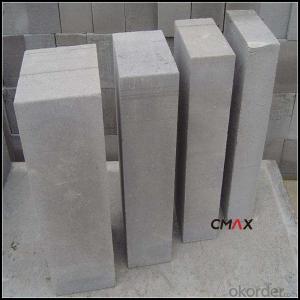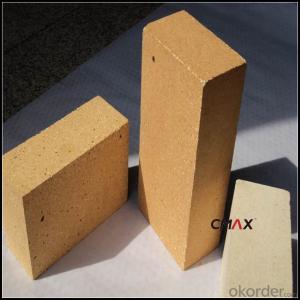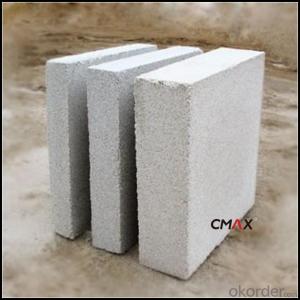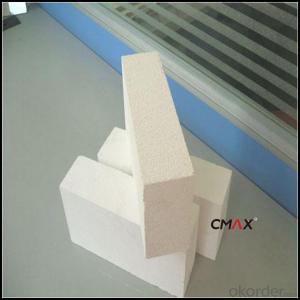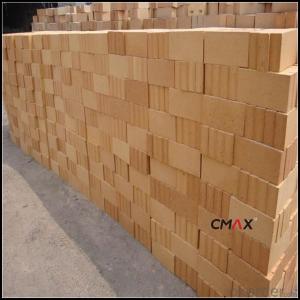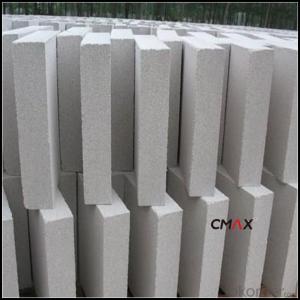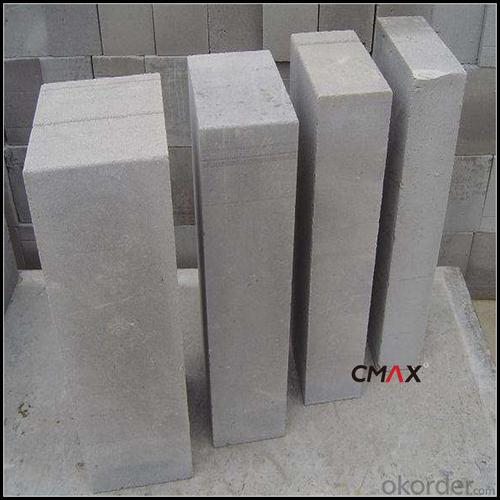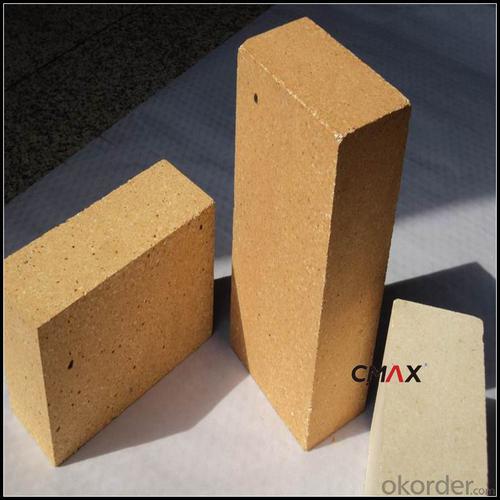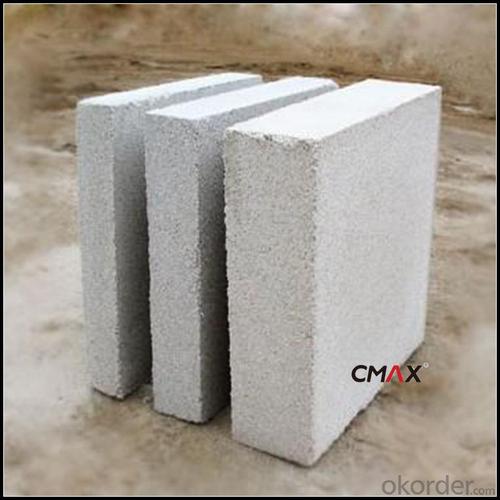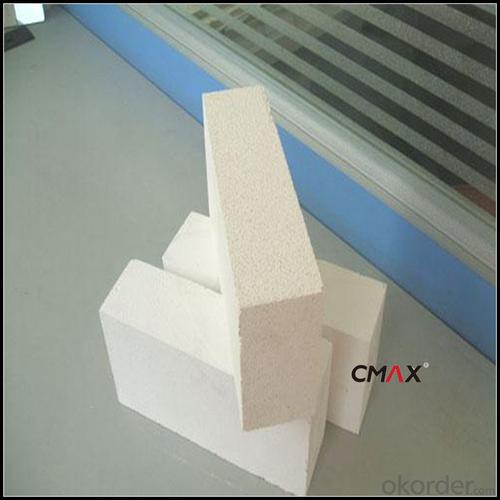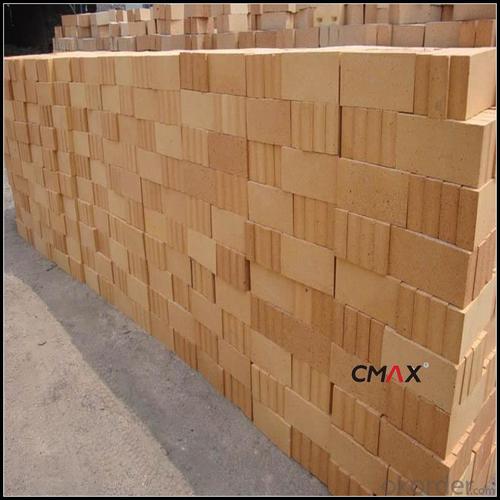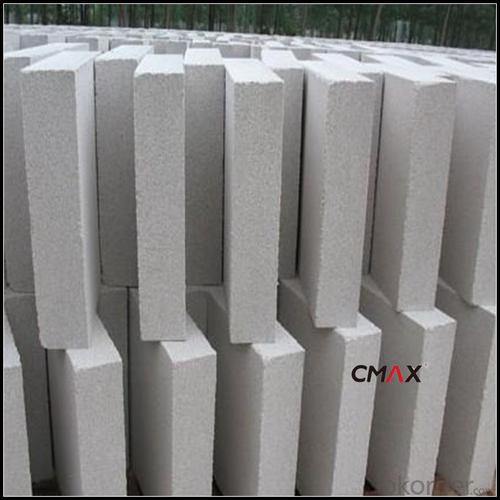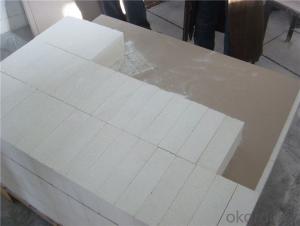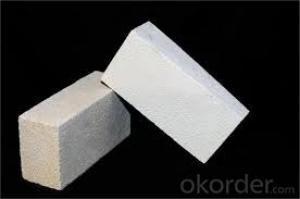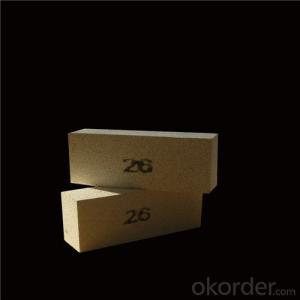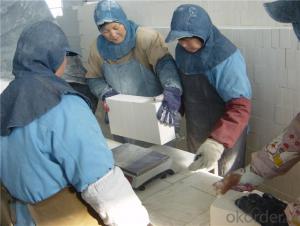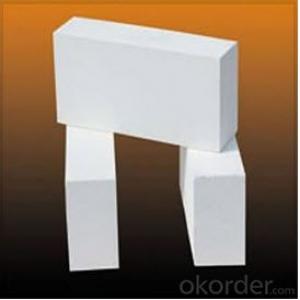Insulating Fire Brick - Refractory Heat Insulation Brick
- Loading Port:
- China main port
- Payment Terms:
- TT OR LC
- Min Order Qty:
- 2 m.t
- Supply Capability:
- 2000 m.t/month
OKorder Service Pledge
OKorder Financial Service
You Might Also Like
Insulating Brick
CMAX insulating firebricks are classified under temperature between 1300℃ to 1700℃, manufactured from high purity alumina clay.
1.High Alumina Brick used for cement kiln, otary kiln and other high temperature kiln.
2,Magnesia Carbon Brick used for converter furnace,ladle and electric furnace.
3,Insulating Bricks used for insualting layer for high temperature furnce
4,Nozzle Bricks slide gate brick that can be used for tundish and ladle
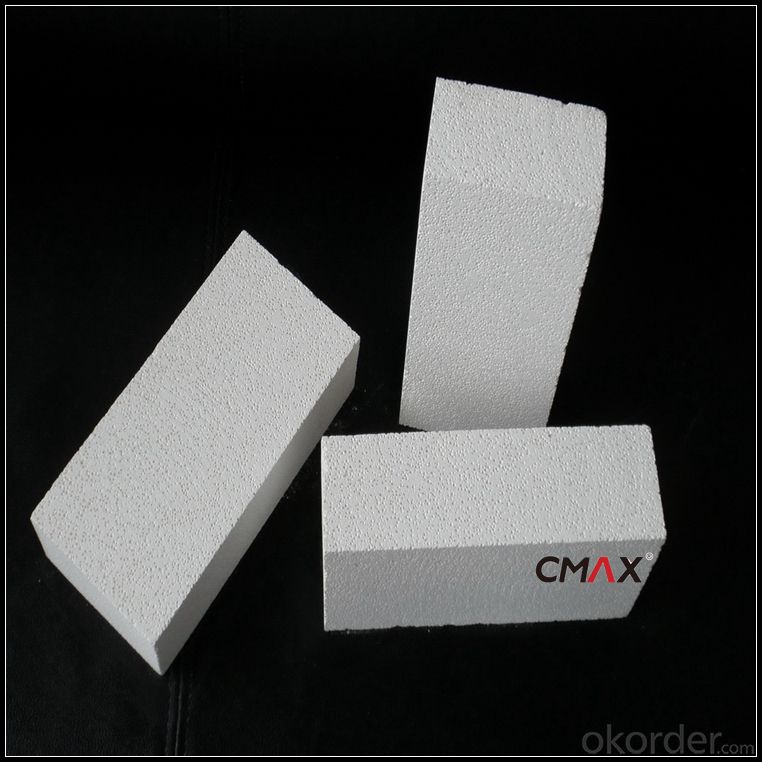
Insulating Brick Features
1.Low thermal conductivity, low thermal capacity, low impurity content
2.High strength
3.Good thermal shock resistance, Corrosion atmosphere resistance
4.High dimensional accuracy
5.Low reheat shrinkage
Insulating Brick Application
glass industries iron & steel industries
ceramics industries non-ferrous metals industries
electrolytic Aluminum industries power generation industries
Heat surface fireproof lining other fire-proof back lining
Process Of Refractory Heat Insulation BrickRaw material to factory→checkout→burdening→stirring→mixing→taking out the raw material
→transfer→enter into mould→press machine extrusion→going out the mould→stoving→going into the furnace
→firing→stopping burn→cooling→open the furnace door→going out the furnace→checkout
→packing→qualified product→putting in storage→sale
Insulating Brick Data Sheet
Classification Temperature (℉/℃) | 3000/1650 |
Bulk Density (g/cm3 ) | ≤1.0 |
Thermal Conductivity | |
800℃, W/m.K | ≤0.39 |
1000℃, W/m.K | ≤0.43 |
1200℃, W/m.K | ≤0.48 |
Reheating Linear Change (%) | 1550℃×12h |
≤0.9 | |
Chemical Composition (%) | |
Al2O3 | ≥75 |
Fe2O3 | ≤0.5 |
Packaging & Shipping
Packaging Details:Be packed in fumigated wooden pallets
Delivery Detail: 30 days after order

Our Services
Optimum solution and product supply of refractories for high temperature industries, such as iron steel, non-ferrous, petrochemical and building materials.
Engineering design, contract and consult for refractories, and civil architecture design.
Research, development, manufacture and sale of superhard materials.
R&D, manufacture and sale of special packing materials for export.
Inspection, supervision and arbitration of refractories.
Consultation and services in refractories information.
Training and cultivation of high-level talents in refractories profession
Sales Network

Company Information
CNBM (China National Building Material) Group is the largest comprehensive building materials group in China that in integrate scientific research, manufacturing and logistics into one entity. The largest building materials and equipment specialists in China. Upon State Council approval, today CNBM owned more than 300 subordinate manufacturing factories and servicing companies. There are 6 fully owned public listed companies and 11 partially owned with substantial shares public listed companies. In many of these fields, CNBM is playing the leading role in the building industry in the country.
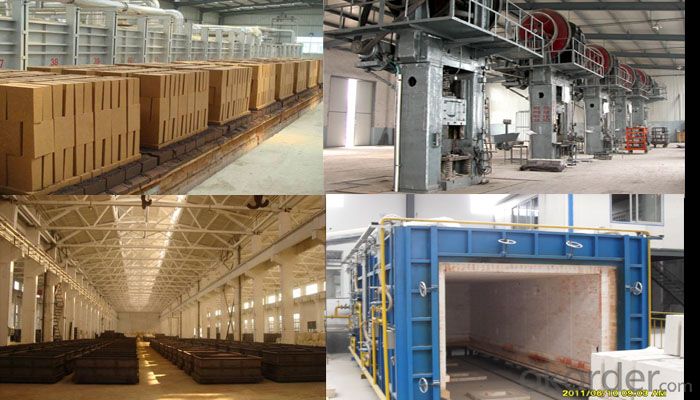
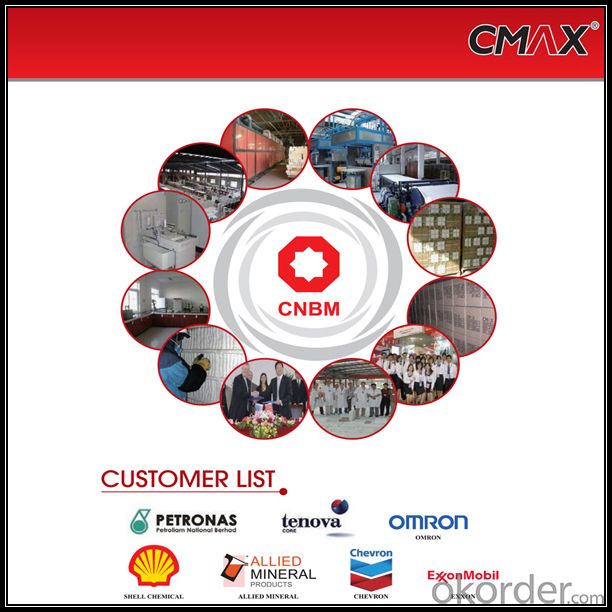
FAQ
1. Which products do you have?
We have all kinds of refractory brick, castable, mortar, cement, ceramic fiber products, etc.
Or you could browse our products to choose what you need.
2. Can you give me a brief introduction of the application of your products?
We are mainly specializing in the refractory materials in iron and steel, cement, glass, ceramics, petrochemical, electric power Industry, etc.
3. If I need your offer, what information do you need?
In order to choose suitable products, it will be appreciated to provide us the information, such us specification, technical data, order quantity, products application etc. If any question, please contact us freely.
- Q: What is the weight of an average insulating fire brick?
- The size and composition of an average insulating fire brick can cause its weight to differ. On average, these bricks weigh around 2.5 to 5 pounds (1.13 to 2.27 kilograms). They are specifically engineered to be lightweight, enabling effortless handling and installation in different thermal insulation applications.
- Q: Can insulating fire bricks be used in the construction of pottery kiln shelves?
- Yes, insulating fire bricks can be used in the construction of pottery kiln shelves. Insulating fire bricks are designed to withstand high temperatures and provide excellent insulation, making them an ideal material for kiln shelves. They can help maintain consistent heat distribution and prevent thermal shock, which is important for firing pottery. Additionally, insulating fire bricks are lightweight and easy to handle, making them a practical choice for constructing kiln shelves.
- Q: What is mullite insulation brick?
- Main features of mullite insulating bricks:1., green environmental protection, non-toxic, non corrosive, safe to use.2. 、 good adaptability with cement.3., light insulation brick with foam mechanism bubble, can get foam uniform bubble diameter.4. excellent foaming performance, foaming multiples of more than thirty times.
- Q: Can insulating fire bricks be used in the construction of fireplaces?
- Yes, insulating fire bricks can be used in the construction of fireplaces. These types of bricks are designed to withstand high temperatures and provide insulation, making them ideal for lining the interior of fireplaces. They help to retain heat, improve energy efficiency, and protect the surrounding materials from excessive heat.
- Q: Are insulating fire bricks resistant to thermal spalling?
- Insulating fire bricks exhibit resistance to thermal spalling, which is the process of a material cracking or fracturing as a result of abrupt fluctuations in temperature or thermal shock. These bricks are specifically engineered to endure elevated temperatures and thermal cycling without spalling. Their low thermal conductivity allows for efficient insulation against heat transfer, thereby reducing the strain caused by thermal expansion and contraction. Moreover, the composition and structure of insulating fire bricks are meticulously designed to offer outstanding protection against thermal spalling, rendering them a dependable option for applications involving intense heat conditions.
- Q: Do insulating fire bricks have good mechanical strength?
- Compared to regular fire bricks, insulating fire bricks typically possess moderate mechanical strength. Although their primary function is to offer exceptional thermal insulation, they can still endure a certain degree of mechanical strain. Nevertheless, it is crucial to acknowledge that their mechanical strength might not be as robust as other fire brick variants explicitly engineered to withstand heavier loads and abrasion. Consequently, if the objective is to attain both high insulation and superior mechanical strength, contemplating the utilization of a blend of insulating fire bricks and regular fire bricks could be necessary.
- Q: What are the main uses of insulating fire bricks?
- Insulating fire bricks, also known as IFBs, are primarily used in high-temperature applications where thermal insulation and heat resistance are required. These bricks are made from lightweight materials, such as clay, silica, and alumina, and are designed to withstand extreme temperatures. One of the main uses of insulating fire bricks is in the construction of kilns and furnaces. These bricks are used to line the walls, floors, and roofs of these high-temperature devices, providing insulation to prevent heat loss and improve energy efficiency. The insulating properties of IFBs help to maintain a consistent and controlled temperature inside the kilns and furnaces, allowing for more efficient heating and cooling processes. Insulating fire bricks are also commonly used in the construction of chimneys and flues. These bricks are resistant to the corrosive effects of flue gases and can withstand the high temperatures generated by the combustion process. The insulation provided by IFBs helps to prevent heat transfer to the surrounding structures, reducing the risk of fire and ensuring the safety of the chimney or flue. Additionally, insulating fire bricks find applications in the manufacturing of fireplaces, pizza ovens, and other outdoor cooking equipment. These bricks help to retain heat within the cooking chamber, allowing for even cooking and reducing fuel consumption. The insulating properties of IFBs also prevent the outer surfaces of these devices from becoming too hot, reducing the risk of accidental burns. Overall, the main uses of insulating fire bricks revolve around their ability to provide thermal insulation and heat resistance in high-temperature environments. Whether in kilns, furnaces, chimneys, or cooking equipment, these bricks play a crucial role in maintaining efficient heating processes, ensuring safety, and conserving energy.
- Q: What is the typical moisture content of an insulating fire brick?
- The moisture content of an insulating fire brick can vary depending on factors such as its specific composition, the manufacturing process used, and the conditions in which it is stored. However, insulating fire bricks are typically designed to have minimal moisture content in order to enhance their insulation capabilities and resistance to thermal shock. Generally, insulating fire bricks have a moisture content ranging from 0.5% to 2%. This low moisture content is crucial in preventing the bricks from cracking or spalling when exposed to high temperatures. Additionally, it reduces the risk of damage caused by moisture, such as freeze-thaw cycles or the release of steam upon heating. To ensure the optimal performance and longevity of insulating fire bricks, it is advisable to store them in a dry environment and protect them from moisture during transportation and installation.
- Q: What is the thermal expansion of insulating fire bricks?
- The thermal expansion of insulating fire bricks is relatively low, typically around 0.5% to 1%.
- Q: Are insulating fire bricks resistant to alkali vapor attack?
- Insulating fire bricks are known for their general resistance to alkali vapor attack. They are crafted from high-quality refractory materials like fire clay or silica, which possess exceptional resistance to chemical assaults, including alkali vapor. These bricks are engineered to endure extreme temperatures and challenging surroundings, rendering them suitable for applications where alkali vapor may be present, such as in industrial furnaces, kilns, and incinerators. However, the level of resistance may vary depending on the specific composition and manufacturing process employed for these insulating fire bricks. To ensure compatibility with alkali vapor exposure, it is advisable to refer to the manufacturer's specifications or seek expert advice.
Send your message to us
Insulating Fire Brick - Refractory Heat Insulation Brick
- Loading Port:
- China main port
- Payment Terms:
- TT OR LC
- Min Order Qty:
- 2 m.t
- Supply Capability:
- 2000 m.t/month
OKorder Service Pledge
OKorder Financial Service
Similar products
Hot products
Hot Searches
Related keywords
